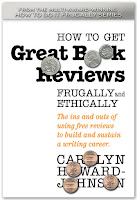Reviewed by Cristina Deptula
On Christmas Day my mother and I enjoyed the most recent version of Little Women in the theater. I nodded with respect when Meg, the most domestic of the sisters, admonished the less traditional Jo, ‘Just because my dreams are different from yours doesn’t mean that they are less important.’
In her most recent poetry collection Thread, Form and Other Enclosures, Carol Smallwood illustrates Meg’s point through a thoughtful arrangement of pieces.
Formal structures—pantoum, triolet, and villanelle—begin the collection, immediately demonstrating the author’s technical prowess. Several of these pieces, and many works throughout Enclosures, deal with domestic objects and activities—quilts, blue jeans, sewing thread, Clabber Girl baking powder. There are even some gently humorous poems, such as a piece on how to discreetly hide one’s undergarments from neighbors who might see your clothesline and a highly structured piece written in upbeat advertising copy language about spandex yoga pants.
While Smallwood writes just as adeptly in free verse and shorter bursts of language later in the book, those formal pieces assert that homemaking, building an everyday life with skill and dignity, is a craft to be mastered, just as much as literature. My mother shared with me not long ago that when she and my father were newlyweds, he asked her why she found Woman’s Day and Good Housekeeping interesting. She told him that he read technology magazines to develop his career, and since at that point homemaking was her career, she was doing the same.
All of this affirms that traditional women’s concerns of cooking, sewing, and mending, and women themselves, are worthy of thought and consideration.
Smallwood’s collection is arranged so as to connect seemingly mundane activities to deeper meaning. Thread holds mended clothing and the squares of a quilt together, and a spool of thread from a woman, Ariadne, allowed Theseus to navigate his way out of the labyrinth after battling the Minotaur. On an even grander level, the ancient Greeks believed three goddesses, Fates, determined our lifespans by measuring and cutting thread. Strings, which can be seen as larger threads, are, in a leading cosmological theory, the building blocks of the universe.
Throughout human history women have invested labor and thought into nourishing people in the kitchen, taking pride in our appearance and that of our homes, creating beauty and order within our surroundings. To Smallwood, these endeavors are a real way of holding society together and laying down the building blocks of our world.
The domesticity Smallwood portrays can also represent enclosure, where women’s lives and contributions take place mostly within the home, the private rather than the public sphere. While women can certainly find meaning and beauty in homemaking, we can also find ourselves restricted by the metaphorical rooms, drawers and cabinets of our lives. Houses with heavy doors, and a husband who demeans and infantilizes, can wrap around and trap us, as Smallwood poignantly illustrates in the piece that references Charlotte Perkins Gilman’s short story The Yellow Wallpaper, where isolation and loss of control over her life drives a female narrator to madness.
Women’s lives have often been marked by enclosure, whether by tradition, societal roles, or our understandable fears of assault and violence. Smallwood’s collection reflects some of this danger, through the aforementioned piece about the abusive husband and another about a male professor who makes crude comments in class.
Another kind of assault present in Smallwood’s collection is cancer, still treated by invasive chemotherapy that causes debilitating side effects. The speakers navigate and survive through a determined embrace, however possible, of freedom and choice. The cup that holds medication becomes a tool saved to capture and release insects trapped in the home, and one can consider the landscape of the Moon while receiving an ultrasound.
Smallwood's formal poetic structures, like the interiors of homes and the rooms, cabinets and boxes within them, represent both sites of beauty, mastery and empowerment and sites of restriction and confinement in women's lives. To reflect this contradiction, she employs a repetitive formal structure for a piece urging writers to throw off their inner censors and speak their minds.
We celebrate along with Smallwood when hair regrows and health returns after successful cancer treatment, as we do when the narrator gets away from the man who boasted she would never leave. Even when life leaves scars, we can sometimes survive, outlast our suffering and retain our beauty, become like the ‘three dolls in pink dresses, showing cracked faces with grace.’
Smallwood’s last two poems in the collection concern greeting card envelopes and McDonald’s, and she returns to formal structures to render these subjects. Her afterword reminds us that ‘beauty comes at us in ordinary moments/full-grown, unexpected.’ Everyday life can be inspiring and lovely, and we can understand the joy that Little Women’s Meg, and many women throughout history, have taken in the ‘threads and enclosures’ of our lives.

This blog is a free service offered to those who want to encourage the reading of books they love. That includes authors who want to share their favorite reviews, reviewers who'd like to see their reviews get more exposure, and readers who want to shout out praise of books they've read. Please see submission guidelines on the left of this page. Reviews and essays are indexed by genre, reviewer names, and review sites. Writers will find the search engine handy for gleaning the names of small publishers. Find other writer-related blogs at Sharing with Writers and The Frugal, Smart and Tuned-In Editor.


No comments:
Post a Comment